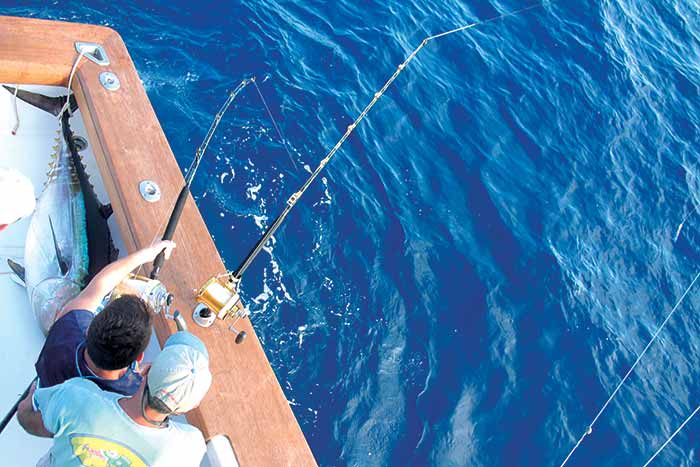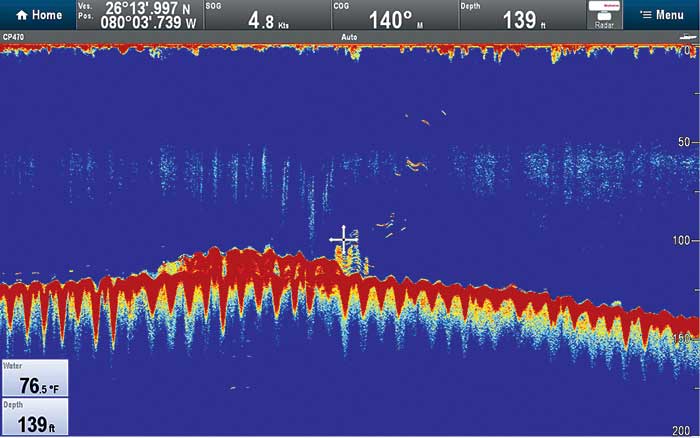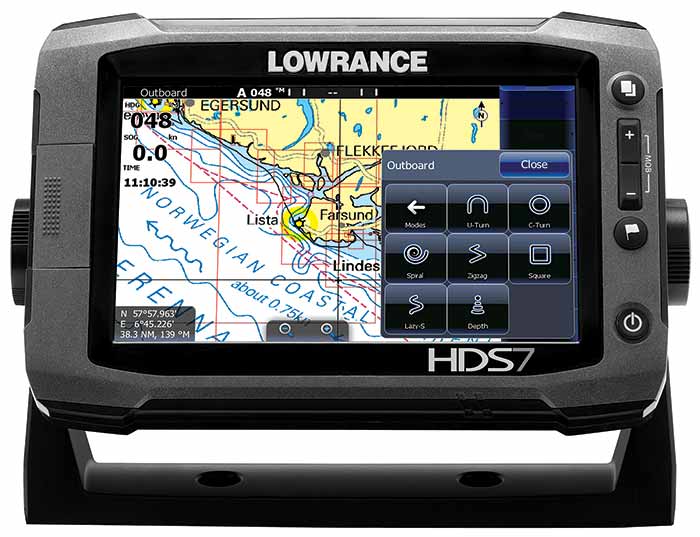Advertisement
Sure, you look for fish with your fishfinder, and navigate to the hotspots with your chartplotter. Well, here are 10 tips for utilizing some of your other electronics, too.

Using your autopilot's cloverleaf mode not only brings you back to the fish but also frees up the captain's hands so he can assist with things like landing the catch or assisting an angler. (Photo: Lenny Rudow)
If you want to learn how to harness the electronic tools at your helm and use them to take analog angling to the next level, it's time to tune in. We're going to serve up 10 simple yet effective ways you can utilize that suite of marine electronics like never before. Try these tricks, and you're guaranteed to catch more fish.
1. Use your autopilot when prospect trolling. And we don't mean so that it drives you in a straight line. Quite the opposite! Virtually all modern autopilot systems have a handful of trolling modes programmed in. One that's vastly underutilized when fishing is the S-turn mode. Most offshore anglers know that fish often strike a lure as it crosses in and out of the propwash or through the boat wake. Savvy captains troll in lazy S shapes. Set your autopilot to S-turn mode when you're searching for fish, and you're likely to find them faster.
2. Use your autopilot after a strike. When a strike does come, you probably know to stab at the MOB button ASAP to make a waypoint. Good. And after you land the fish, you probably troll right back toward that waypoint. Also good. But what do you do after crossing it? Do you keep going, wondering exactly when you should circle back? That's what most of us do, and it's a mistake. You should let go of the wheel and set the autopilot to cloverleaf mode. It'll circle back over the spot from different directions to create a cloverleaf pattern, probing the water to all sides of the waypoint. Whichever way the fish have moved, you'll troll over them, and if they haven't moved from that original spot, you'll still troll over them.

Thermoclines, seen here as the blue marks just below 50 feet, will appear as light, broken returns that continue along a consistent depth.
3. Use your fishfinder to locate a thermocline. Thermoclines are temperature barriers lying more or less horizontally between two bodies of water. These temperature barriers provide a structure of sorts, and many species of fish in all varieties of freshwater and saltwater congregate around them. You can spot a thermocline simply by goosing up the sensitivity on your fishfinder. It will appear to be a broken, relatively weak return displayed in green or blue at a fairly consistent depth. When you find one, try fishing just above and/or just below it.
4. Survey your digital charts for abrupt contour changes that mirror known hotspots. Do you have a few local hotspots with significant bathymetric variations, like steep drop-offs, ledges, or underwater humps? If so, zoom in on them with your digital cartography, and take note of details specific to that spot, like the amount of depth change, the abruptness of the change, and geographic orientation. Then zoom out and look for similar bathymetric anomalies in the same body of water. If you can find one or two, make some waypoints and put them on your list of potential hotspots.

Your autopilot can be used in a number of ways as a fish-catching tool.
5. Use your radar to find birds. OK, you've probably heard you can do this, but not many anglers do. Part of the reason is that, historically, you needed an extremely potent radar for this to work. Modern units that focus on delivering high sensitivity at relatively short ranges, like Broadband Radar, have no problem marking small clusters of our feathered friends from miles away. Another reason few anglers successfully utilize radar to find birds has to do with how crowded our waterways have become. On any given weekend, there may be so many targets inside of 10 miles that your radar screen looks like you're in the middle of a mega-raft-up. Try this: Reduce range to just a mile or two. You'd be amazed at how often we miss a patch of a dozen or so birds from just half a mile away, and even on short ranges like this, you'll locate birds you hadn't noticed with the naked eye.
6. Zoom your GPS all the way in when pinpoint positioning over wrecks or small structures. Remember, that boat icon on your screen takes up the same amount of space whether you're looking at the entire Atlantic Ocean or a 100-square-foot segment of it. If you fish with your GPS set to any scale measured by the mile, your boat icon may well represent an area hundreds of feet long. You can't possibly position the boat icon over the waypoint icon and expect any decent level of accuracy. Instead, zoom in so your entire screen scale is 100 feet or less. Then the icons are a much more realistic representation of reality, and you can better judge where to position yourself to catch those fish.
7. Use AIS to find commercial fishing boats. Sure, we all want to catch fish, but those commercial guys depend on it for a living. They're out on the water a lot more often, and they commonly know far more about where the fish are schooled up at any given time. Find them, and you'll often discover the hotspot du jour. In some fisheries (like chasing blackfin tuna and bonito along the Gulf Coast), finding commercial trawlers (in this specific case, shrimpers) is the best way to find success. With AIS, you'll know where they are at any time of day or night.
8. Use your anchor alarm as a drift perimeter. How many times have you been fishing a drift, then looked at the chartplotter and realized that you passed beyond the hotspot long ago? You can eliminate this common snafu by setting your anchor alarm to alert you when you've drifted outside the strike zone.
Tip: Remember that your primary obligation is careful navigation, including keeping watch for other boats and hazards.
9. Use your fishfinder to determine bottom type. Some species gather over oyster shells. Others like a rocky bottom, and still others congregate over a mud or vegetated bottom. You can identify the bottom below you by using your fishfinder. At least one manufacturer (Furuno) has bottom-discrimination features that display which is which, right on the screen. But you can use any fishfinder to determine what type of bottom lies below by looking at the width of the bottom line. Since the transducer's signal partially penetrates a soft bottom, it creates a thick line on your monitor. Quickly reflected signals hitting rocks, however, create a very thin line. With time and experience, you can learn to differentiate between the specific types of bottoms you encounter.
10. Track the drift of a temperature break with your waypoints. Sometimes a temperature break holds all the action, but it's easy to lose one as it moves with the current. You can, however, track the direction and approximate speed of a moving break with your chartplotter and its waypoints. Simply choose an unusual-looking waypoint icon that you don't normally use, and whenever you cross the break, plug it in. Don't name these waypoints, but instead allow the chartplotter to automatically assign them increasing numbers. Over time, you'll notice that lower-numbered waypoints are no longer on the break. Then you can look at where the higher-numbered (newer) waypoints are to determine the direction and speed of the moving break.
